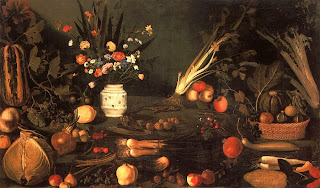Caravaggio (1573-1610) |
Caravaggio was an Italian baroque painter who was the best exemplar of naturalistic painting in the early 17th century. His use of models from the lower classes of society in his early secular works and later religious compositions appealed to the Counter Reformation taste for realism, simplicity, and piety in art. Equally important is his introduction of dramatic light-and-dark effects—termed chiaroscuro—into his works.
Originally named Michelangelo Merisi, Caravaggio was born September 28, 1573, in the Lombardy hill town of Caravaggio Metropolitan Museum , New York Paris , and the Museo Capitolino, Rome
Caravaggio's mature manner commenced about 1600 with the commission to decorate the Contarelli Chapel in San Luigi dei Francesi in Rome Rome
Caravaggio's personal life was turbulent. He was often arrested and imprisoned. He fled Rome for Naples Naples Malta Syracuse in Sicily Sicily he painted several monumental canvases, including the Burial of Saint Lucy (1608, Santa Lucia, Syracuse ) and the Raising of Lazarus (1609, Museo Nazionale, Messina Tuscany
Although the use of both realistic types and strong chiaroscuro originated in northern Italian art of the previous century, Caravaggio brought new life and immediacy to these aspects of painting, with which he effected a transformation of anticlassical Mannerism in early baroque Rome Italy
.jpg)
.jpg)


.jpg)


.jpg)
).jpg)



.jpg)



.jpg)

.jpg)




.jpg)




.jpg)

.jpg)
.jpg)

.jpg)



.jpg)

.jpg)
.jpg)



0 comments:
Post a Comment